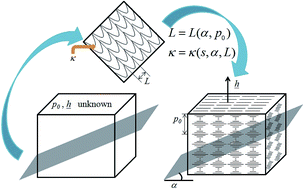Structure characterisation method for ideal and non-ideal twisted plywoods†
Abstract
The twisted plywood architecture, known as the Bouligand structure, is a ubiquitous biological and synthetic fibrous composite structure, analogous to that of cholesteric liquid crystals. Twisted plywoods can show ideal or non-ideal structures and are formed via equilibrium or non-equilibrium liquid crystal self-assembly processes. A key to the structure characterisation of plywood films is the specification of the local and global helix vector h(x) and pitch p(x) of the cholesteric order. Previous extensive work demonstrated that oblique cuts of the plywood give rise to arc-patterns that depend both on the unknown incision angle α and the unknown pitch p(x), thus making the precise 3D cholesteric reconstruction ambiguous. In this paper we present an efficient method based on geometric modelling and new visualization software that determines unambiguously the cholesteric pitch under spatially homogeneous and heterogeneous conditions. The method is applied to films that display two-pitch and spatially non-homogenous structures, as sometimes observed under equilibrium and non-equilibrium self-assembly. The method can be extended to other biological materials such as cornea-like, cylindrical, and various cuticle plywoods.


 Please wait while we load your content...
Please wait while we load your content...